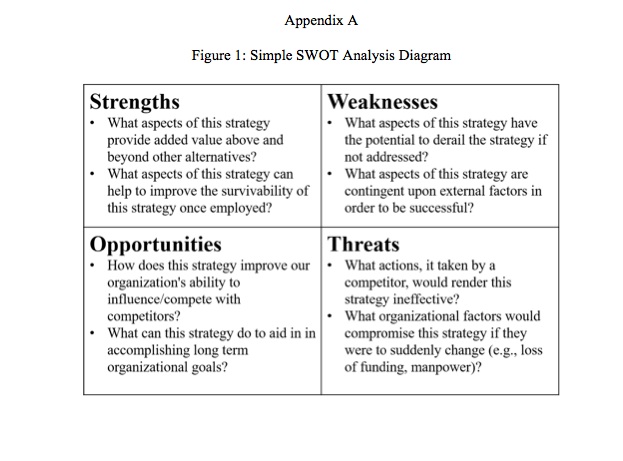
Imagine you have spent the last month developing a marketing proposal for your company and you are certain this one is sure to succeed. While you are certain of the benefit of this proposal for your company, you hope your proposal will be well received by your superiors. While you are preparing to present your proposal, you mentally run through a list of hypothetical questions you may be asked: How much will this cost? What is the return on investment? Have we considered other options? You feel confident you can handle all the questions that come at you, except for one: What will our competitor do?
This is a difficult question to answer. Picture the scenario like a chess match. After carefully examining all the pieces on the board, you have selected the perfect move. The problem is that once you move, the game is no longer in your control and it is up to your opponent to respond. While a chess game may be trivial, the month you spent creating a marketing proposal is anything but trivial and may have some serious ramifications for your company if your competitors can outmaneuver you.
This is not a new problem, nor is it unique to today’s business world. For centuries, rulers and military commanders have been faced with the same question: If I do x, what will my opponent do? Fortunately, there is a solution available to help answer this question: It’s called Red Teaming. Red Teams provide a unique opportunity to test a strategy prior to actually engaging with your competitor. Red Teams are a process that can be used in high-risk scenarios and are routinely used in U.S. military operations today. For instance, the 2011 Navy Seal raid on Osama Bin Laden’s compound in Pakistan was heavily Red Teamed prior to the actual operation. Despite numerous setbacks, including a helicopter crash landing, the Seal team was still able to accomplish their mission (Zenko, 2015).
While you might not be running special operations in the Middle East, Red Teams can be used in any organization and can provide a great opportunity to pressure test your ideas before they hit the market.
What Are Red Teams?
The idea of a Red Team has been around for centuries and traditionally has been referred to as war games or war gaming. The name, “Red Team,” is a more recent addition that was developed as a result of Cold War terminology (e.g., the U.S. was considered the Blue Team, and the USSR was the Red Team). Red teaming can be defined as “a function that provides commanders an independent capability to fully explore alternatives in plans, operations, concepts, organizations, and capabilities in the context of the operational environment (OE) and from the perspectives of partners, adversaries, and others” (University of Foreign Military and Cultural Studies, 2015, p. 2). Simply put, a Red Team is a small group of individuals from inside one’s own organization who are given the task of becoming a virtual or surrogate enemy. Similar to the idea of selecting an individual to be a “devil’s advocate” within a group, a Red Team can provide similar feedback as a team. The added benefit of Red Teaming to a difficult problem or situation is that it can provide a “structured and iterative process executed by trained, educated, and practiced team members with access to relevant subject matter expertise” (Fontenot, 2005, p. 4).
Red Teams provide a unique approach to a problem by providing feedback on one’s intended actions, as if it were coming directly from an opponent or competitor, without the associated risk. Red Teaming also reduces the opportunity for groupthink to occur by ensuring that there is a contrarian viewpoint present (provided by the Red Team).
Despite the fact that Red Teams are regularly used within the U.S. military, there is little formalized training or procedures available on Red Teaming (Fontenot, 2005). While much of the literature on Red Teams is directed at military operations, these practices also can be easily implemented into daily business operations, thereby providing the organization with a cutting-edge strategy for outmaneuvering their competitors.
Creating Your Own Red Team
Creating your own Red Team is a simple, straightforward process that requires minimal time and little to no cost. To set up and implement your first Red Team, start by using four simple steps:
- Select
- Empower
- Refrain
- Evaluate
These steps should be followed in the order presented here, ensuring that your team is properly informed and equipped to provide you with actionable results.
Select the Team
You should select a small team of approximately three to five members who are familiar with both your organization and your competitor(s). The team members should be competent in their own jobs and well respected within the organization. They should be given the time and resources to become a strong competitor who can provide more than superficial insights.
Empower Your Team
It is important that you fully explain the extent of your expectations for the team. This may involve presenting a brief overview of Red Teaming. You are granting this team permission to be disruptive, to misbehave, and to challenge commonly accepted organizational beliefs and practices. It is crucial that your Red Team understand that, although professional boundaries will be maintained, the feedback they will be providing may be controversial and they are encouraged to do so. If you feel this will be an issue, make sure the team includes one or two members who can challenge organizational norms in a way others will respect.
Refrain
Ensure that both you and your management team are able to check your own biases at the door. It is important to remember that you are requesting that your Red Team evaluate your organization’s actions from the perspective of your competition. This also could involve receiving feedback on your own practices and projects. While this might not always be a pleasant process, it is important that you refrain from interjecting your own opinions into the Red Team and allow them to be as objective and honest as possible. To better manage yourself, remember that this is a simulation, a game, to find out what the competitor will do before they do it. Ultimately, you are all on the same team!
Evaluate
Select what kind of feedback you would like to receive from your Red Team and how you would like the information presented. This could involve simply having the Red Team present in meetings to provide an informed perspective during a planning process. It may be more beneficial to have the Red Team provide written feedback in the form of a SWOT analysis, which is explained below (University of Foreign Military and Cultural Studies, 2015). This feedback could be presented prior to launching a new product or initiative, or it may be requested multiple times throughout a project (e.g., monthly, quarterly). It is up to you to determine what kind of feedback will be most beneficial to you and your organization.
Actions to Avoid
As difficult as it may be for a Red Team to think and act in ways a competitor might, additional difficulties may arise from within your own organization. A group’s collective ideas and plans for the future can be deeply rooted, and the divergent thinking provided by a Red Team might not always be welcomed. Fortunately, just as knowledge about an opponent is beneficial, understanding how your own organization or team will react to this process is also beneficial. To enhance your Red Teaming process, be aware of two key threats identified by the Department of Defense Task Force. Your Red Team is more likely to fail if it begins to:
- “Lose its independence and be ‘captured’ by the bureaucracy” (Department of Defense Task Force, 2003)
- “Be too removed from the decision-making process and become marginalized” (Department of Defense Task Force, 2003)
Fortunately, these problems can be avoided by explaining the purpose of your Red Team to your organization up front. It is important that your organization understand that the Red Team is supposed to act as a disruptor and present observations that will be controversial. It is crucial that you ensure that your Red Team is included throughout your organization’s planning process and that they are empowered to perform as originally requested. Your Red Team can provide powerful observations about weaknesses within your organization’s strategy and the areas in which competitor is most likely to capitalize. It is important that your Red Team be given a voice throughout the project in order receive the insights they have to offer.
What to Do Next?
If you have your own Red Team set up, and you have taken the proper precautions to ensure they are allowed to function properly, then the next step is to decide what kind of feedback or report you would like your Red Team to provide. There are several methods available to interpret the findings and recommendations of Red Teams, including SWOT analysis, alternative futures analysis, and analysis of competing hypotheses. In this article, the SWOT (strengths, weaknesses, opportunities, and threats) analysis will be used as an example. SWOT analyses are common in organizations today and provide a simple way evaluate an organization’s strategy.

This will be a SWOT analysis that your direct competitor created about your organization. What will your competitor see as your weaknesses or threats? What opportunities does it hope you don’t see? Your Red Team can provide this analysis for your organization by putting themselves in the mindset of your competition. Additionally, there is no limit to how many SWOT analyses your Red Team provides. For instance, you may find it beneficial to request that your Red Team provide an initial assessment prior to releasing a product in a new market, and another one three months or a year into the release.
Today’s business world is fast moving and rapidly evolving, especially when considering global markets. With this in mind, competitors also will be ever present and evolving just as quickly. Using Red Teaming practices within your organization can help to tip the scales in your favor, providing a crucial advantage in an uncertain world.
REFERENCES
Department of Defense Task Force (2003). The role and status of DOD red teaming activities. Tech. rep., Office of the Under Secretary of Defense for Acquisition, Technology, and Logistics.
Fontenot, G. (2005). “Seeing Red: Creating a red-team capability for the blue force.” Military Review, 85, 4-8.
University of Foreign Military and Cultural Studies (2015). “Applied Critical Thinking Handbook.” Fort Leavenworth, Kansas: U.S. Army Training and Doctrine Command.
Zenko, M. (2015). “Red Team: How to succeed by thinking like the enemy.” Basic Books.
Keith A. Price is a doctoral student of I-O Psychology at Seattle Pacific University.




